Killifish are small egg-laying toothcarp fish that inhabit freshwater or saltwater environments. There are around 1,270 different species of killifish, and a number of them are kept as pets or used for commercial purposes. Each of these species is either annual, semi-annual, or annual depending on their growth and reproductive strategies. Most killifish reach an adult size of two to three inches, making them excellent for smaller aquariums.
This article will discuss 14 types of killifish, along with their care requirements and breeding habits.
Types of Annual Killifish
Certain killifish only live for a wet season in their habitat. They generally inhabit temporary bodies of water and complete their lifecycle within one year. Annual killifish are rapid growers and reach sexual maturity quicker than other species. These types of killifish live this way because their body of water dries up after the wet season and becomes uninhabitable. However, their eggs are capable of surviving during the dry period.
1. Bluefin Notho
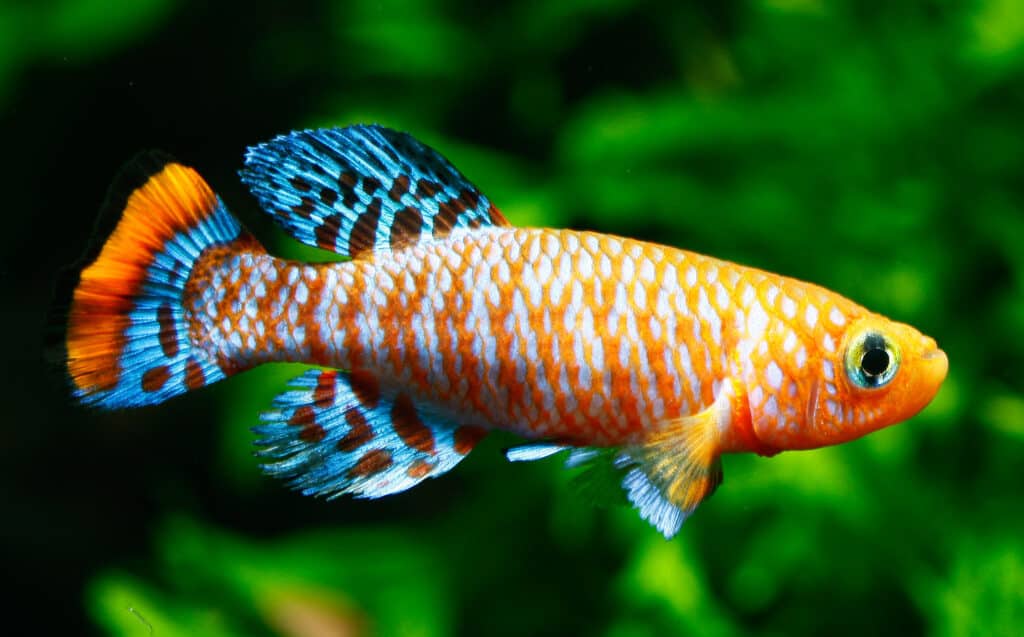
Because of their strikingly beautiful colors, killifish are very popular among fish enthusiasts with home aquariums.
©Pavaphon Supanantananont/Shutterstock.com
The bluefin notho or Nothobranchius rachovii killifish is a small species that offers aquarium keepers a touch of color. The bluefin notho killifish is native to central Mozambique in the Zambezi River. They grow to a maximum adult size of 2.5 inches and have brilliant blue fins with reddish-orange bodies.
Caring for a bluefin notho is relatively easy and can be done by beginner aquarists. These killifish are social, so they should be kept in a species-only tank. However, more experienced keepers may be able to keep these killifish in a communal aquarium.
In terms of breeding, the bluefin notho benefits from having peat in the aquarium. They will bury their eggs in this substrate and these eggs can be stored in moist conditions at room temperature.
2. Redtail Notho

The redtail notho is similar to the bluefin notho in terms of care and breeding habits.
©aqua_p/Shutterstock.com
The redtail notho or Nothobranchius guentheri is a similar species of killifish endemic to Zanzibar. Redtail nothos are similar to bluefin nothos, except that they have predominantly red fins. Redtail nothos grow between 2 to 3 inches in size and have an average lifespan of six to 12 months in the wild and captivity. Their breeding habits and care level is the same as the bluefin notho.
3. Argentine Pearlfish
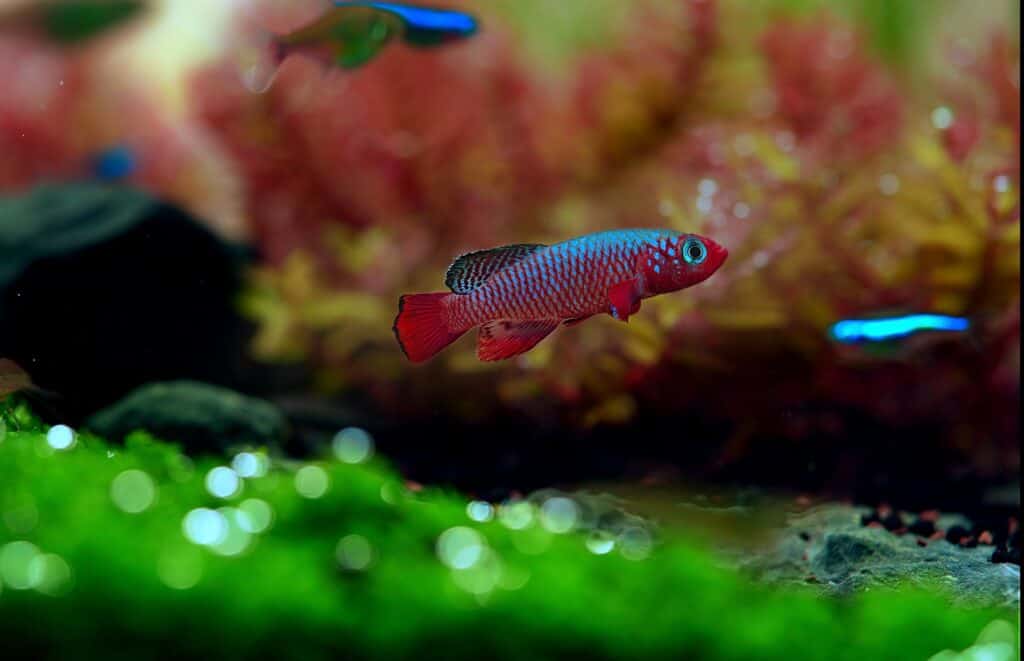
With so many species of killifish, they vary significantly in appearance. However, all these species have one thing in common: their bright coloring and eye-catching patterns.
©Selosh/Shutterstock.com
One of the less colorful killifish is the Argentine pearlfish, scientifically known as Austrolebias nigripinnis. This type of killifish is native to the Uruguay and Argentina rivers, where they prefer colder water temperatures. The Argentine pearlfish has a deep blue coloration with a blackish-grey body and white dots.
Most Argentine pearlfish reach an adult size of 2.5 inches and can be kept in tanks as small as 10 gallons. They can be semi-aggressive, so you can keep two females in a tank. However, beginners should be cautious about housing them with peaceful long-finned fish. Adding a layer of peat to the substrate can be useful for breeding purposes.
Types of Semi-Annual Killifish
Semi-annual killifish have similar characteristics to annual and non-annual killifish. This means that while they do live longer than annual killifish, they don’t live as long as non-annual ones. Furthermore, their eggs take longer to hatch than non-annual killifish.
1. Blue Lyretail

There are 1270 species of killifish, which all vary in color, size, and shape.
©slowmotiongli/Shutterstock.com
The blue lyretail or Fundulopanchax gardneri killifish is endemic to Cameroon and Nigeria. Here they inhabit freshwater habitats in the savanna and forest regions. Male blue lyretails are generally larger and more colorful than females. They typically reach a size of 2.5 inches in captivity and require a minimum tank of 11 to 20 gallons. Blue lyretail killifish are considered easy to maintain, making them a good choice for beginners.
Blue lyretail killifish have a striking yellow body with blue dots and a lyre-shaped tail fin. The males can be territorial and aggressive with one another, so care should be taken when housing them together. You may find that they are challenging to breed in captivity and need specific breeding conditions to be successful. Live plants and an increase in water temperature can help encourage spawning activity.
2. Large-Finned Lampeye
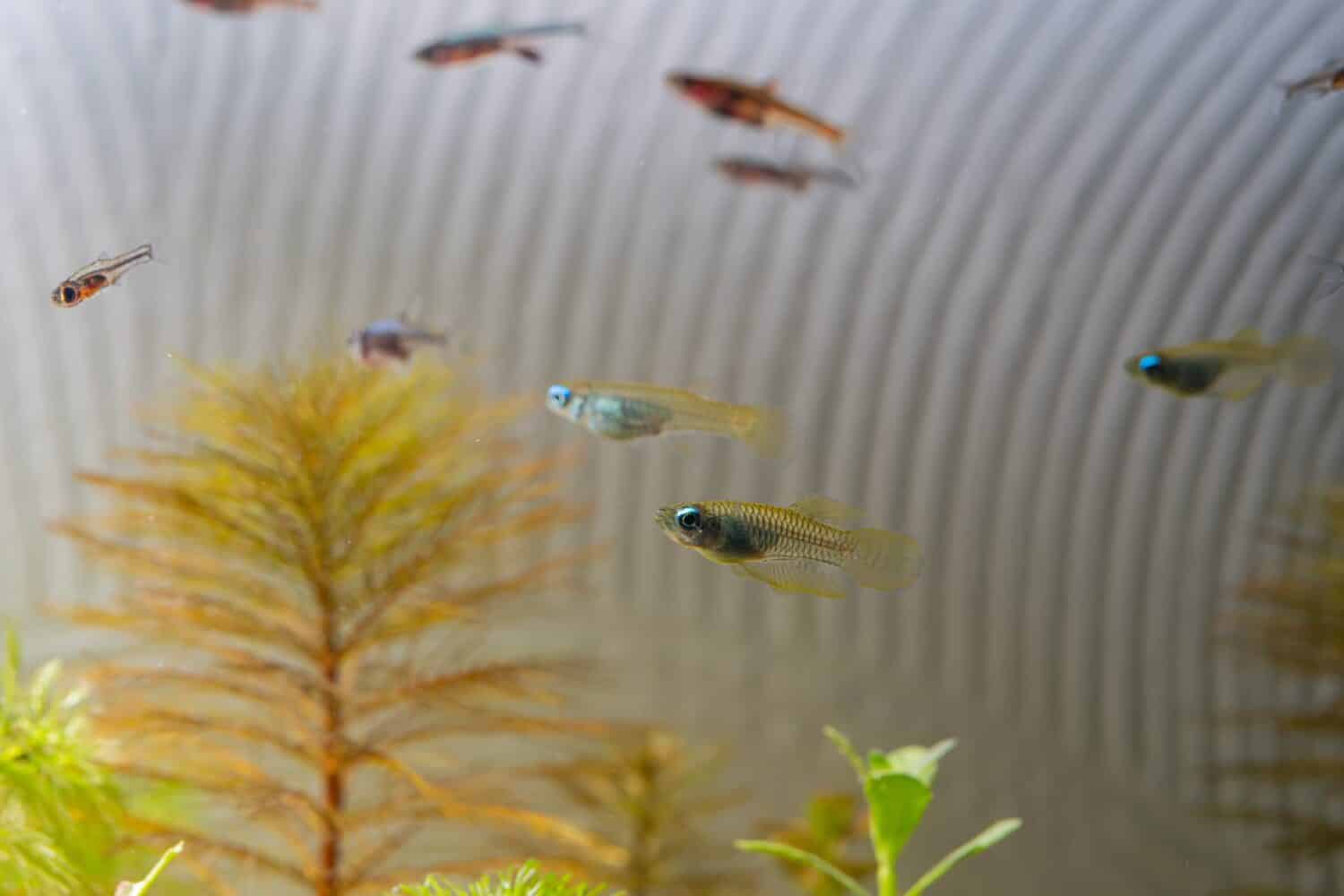
Not all killifish are colorful, especially the females.
©richardernestyap/Shutterstock.com
Large-finned lampeye or Procatopus notoaenia is native to Cameroon and Nigeria in tropical freshwaters. They aren’t as colorful as some other killifish and have a bluish-yellow body and reddish fins. The males are generally larger and more colorful than the females. Despite their name, they only reach an adult size of 2.5 inches in captivity. They are relatively easy to care for and breed, and they spawn best in planted aquariums. Most large-finned lampeye have an average lifespan of two to three years.
Types of Non-Annual Killifish
Some of the most popular killifish kept as pets are non-annual killifish. These types of killifish inhabit permanent bodies of water that do not experience a dry season. They grow much slower than annual and semi-annual killifish and have a longer lifespan.
1. Red Lyretail
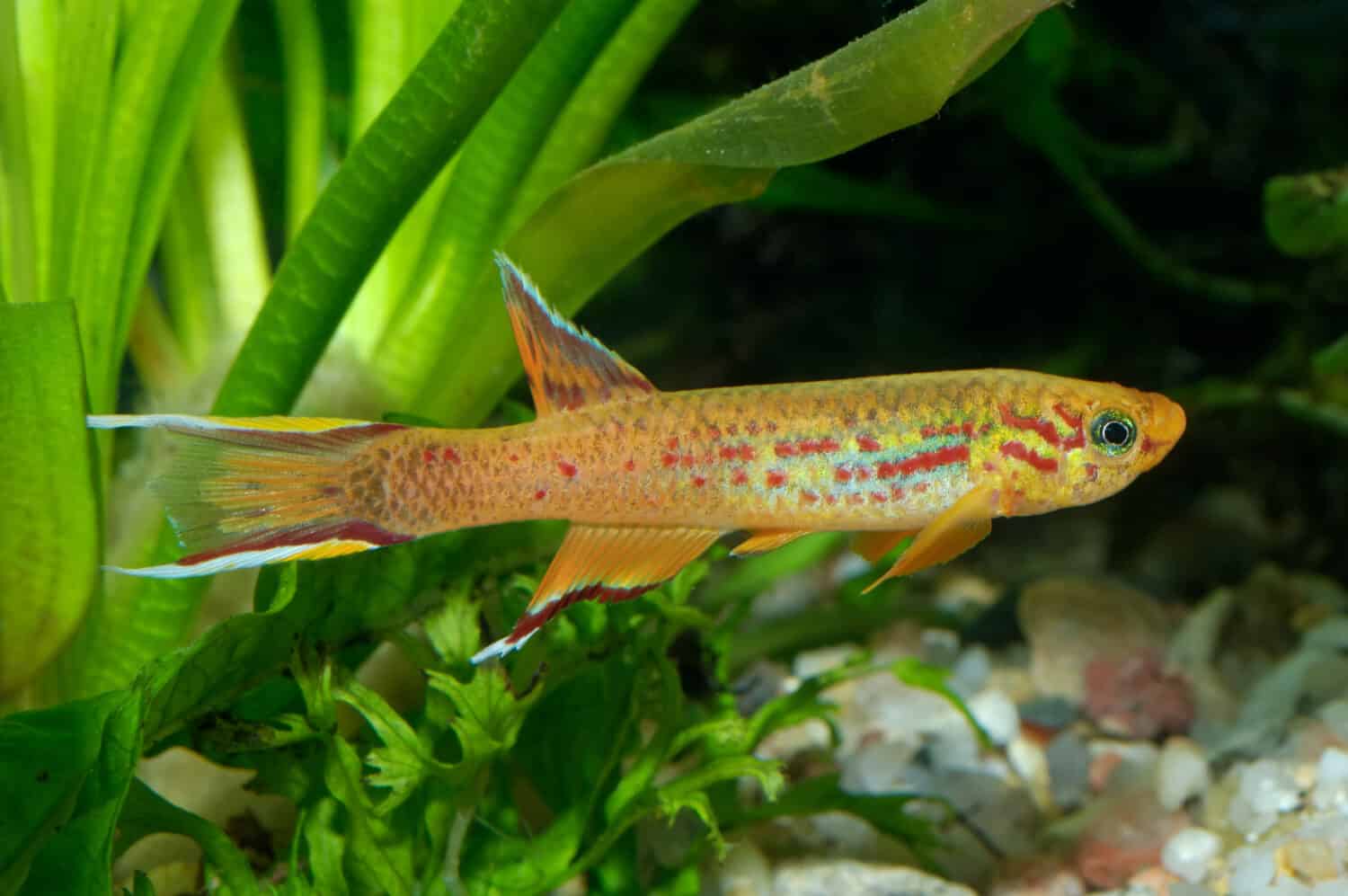
The red lyretail killifish have a unique tail fin.
©NERYXCOM/Shutterstock.com
Red lyretail or Aphyosemion bivittatum killifish can be found in West Africa. They have a lifespan of three to five years as pets and reach an adult size of three to four inches. The male red lyretail is particularly striking, with vivid orangish-red coloration. They are distinguished by their lyre-shaped tails that resemble two swords. Most red lyretail killifish are easy to care for, but they do require a slightly larger tank than other killifish due to their size.
Unfortunately, male red lyretails are sterile so they reproduce artificially.
2. Clown Killifish
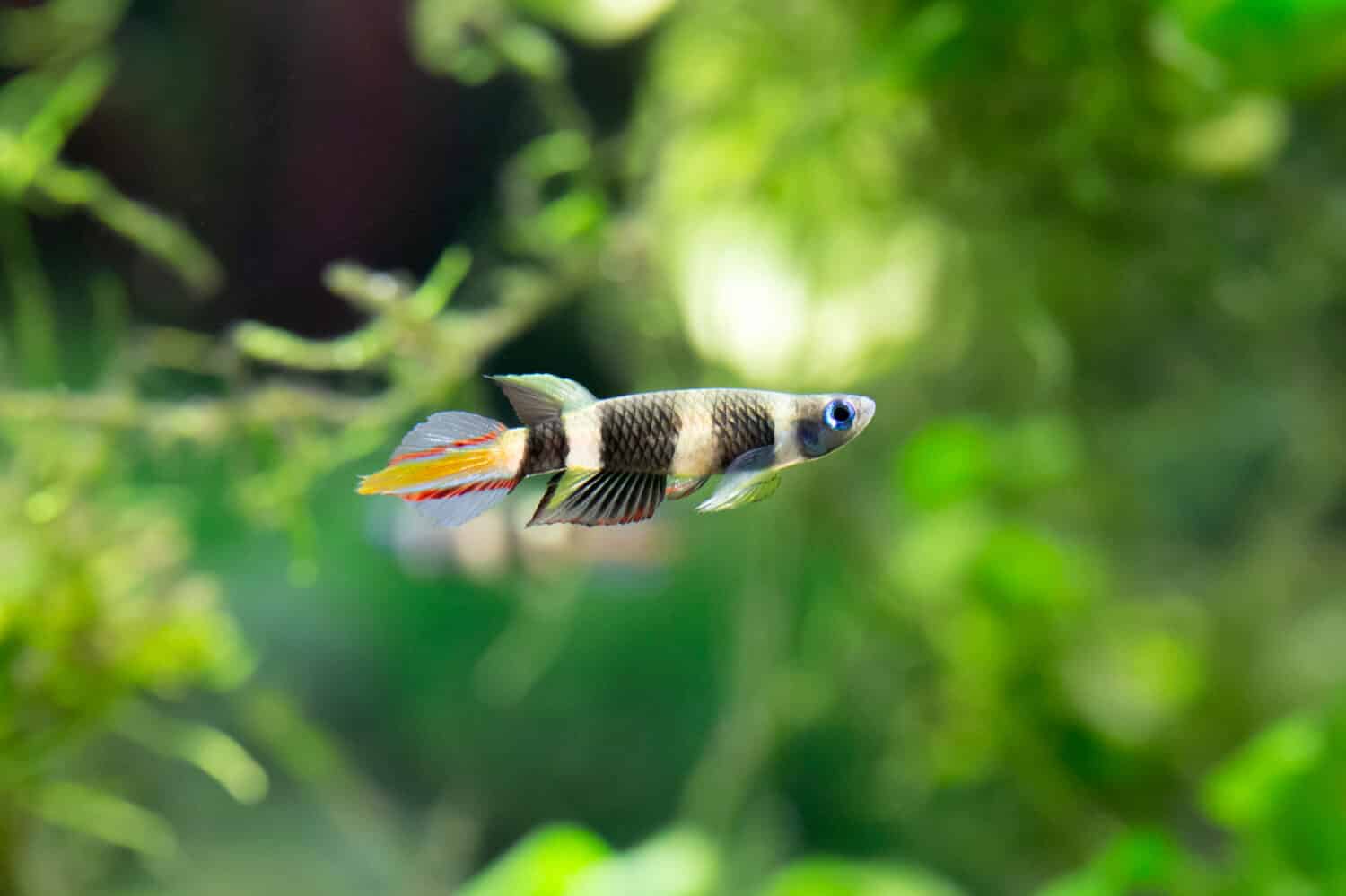
Male clown killifish have striking rainbow tails and banded bodies.
©boban_nz/Shutterstock.com
Clown or banded killifish, scientifically known as Epiplatys annulatas, is endemic to West Africa. They are distinguishable with their banded markings that closely resemble Khuli loaches. In captivity, clown killifish are capable of living for around three to five years when well cared for. They have a relatively small size of 1.5 inches and grow relatively quickly. This makes them a good choice for nano aquariums, where they can be kept with other small and peaceful fish. Clown killifish thrive on a diet consisting of small live foods such as daphnia or baby brine shrimp.
When it comes to breeding clown killifish, it is relatively easy. They breed when the conditions are ideal, preferably in densely planted tanks with no predators. The males are selected with a rainbow tail fin, which the females do not have.
3. Golden Lyretail
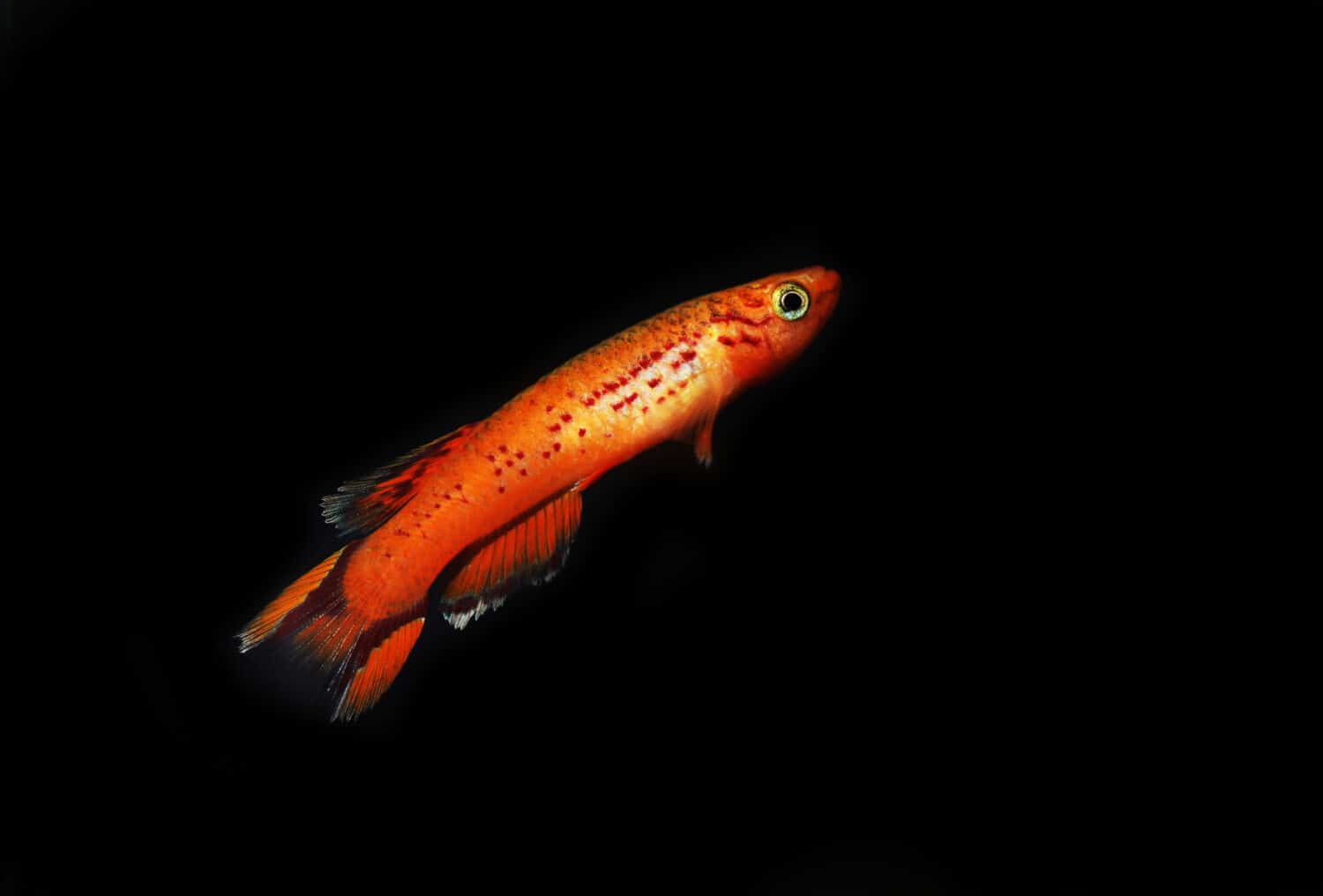
Most golden lyretail killifish do well in small aquariums due to their small size.
©Pavaphon Supanantananont/Shutterstock.com
The golden lyretail or Aphyosemion australe is native to Central Africa where they inhabit waters along the Atlantic coastline. The golden lyretail is a peaceful species of killifish that reaches a size of 2.2 inches. Their lifespan averages around two to four years in captivity. They have a red coloration with blue stripes and speckling on their bodies. As usual, the male is more colorful than the female.
Most golden lyretail killifish thrive in a freshwater aquarium with a size of 10 to 20 gallons. With the right conditions, golden lyretails are easy to breed in well-conditioned pairs.
4. Red-Striped Killifish
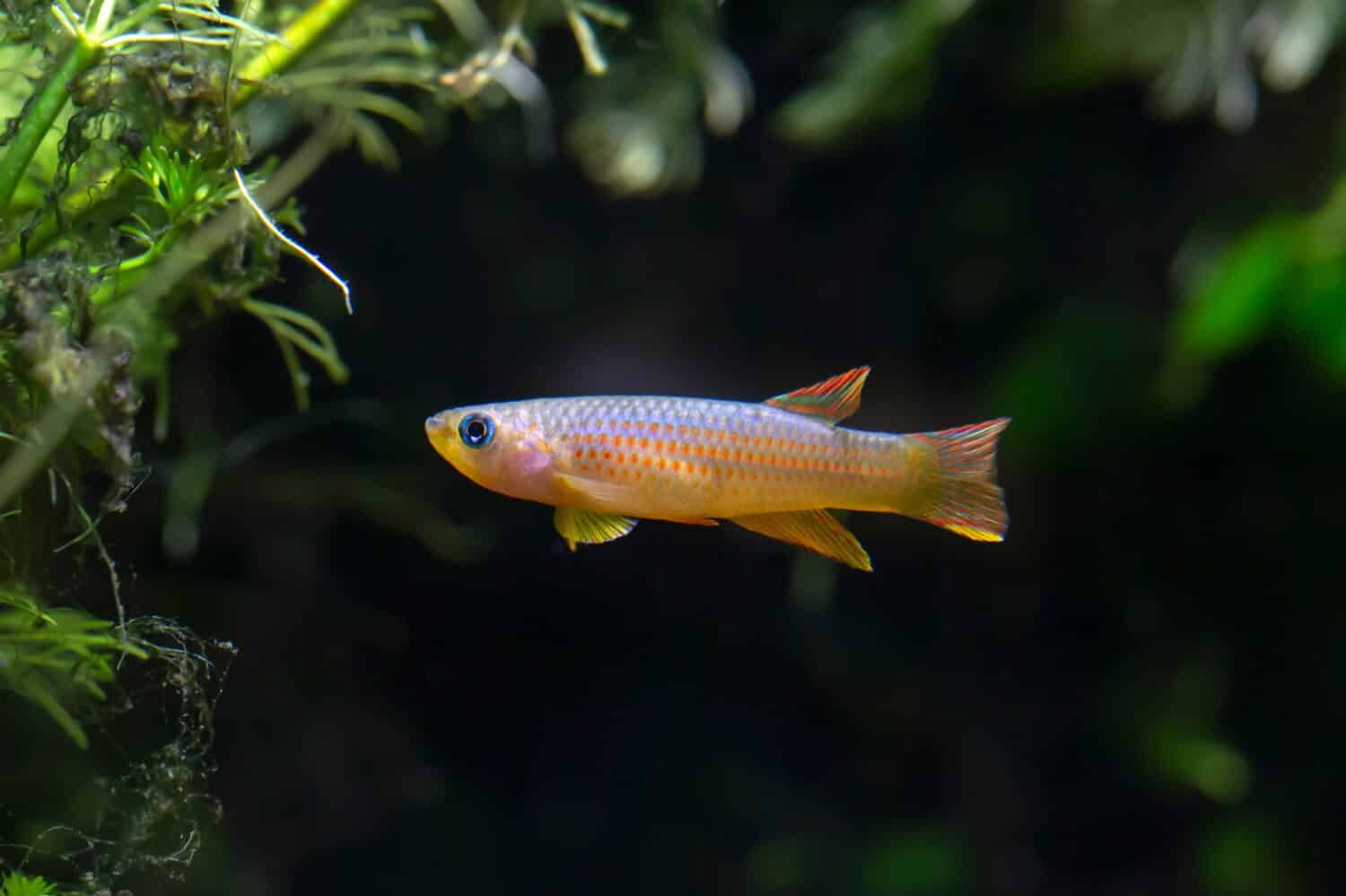
The red-striped killifish has a relatively simple coloration.
©boban_nz/Shutterstock.com
Red-striped or Aphyosemion striatum are vividly colored fundulid killifish native to Guinea and Gabon. Here they inhabit slow-moving freshwaters like swamps and rivers. Their appearance is quite distinguishable since it almost appears as a rainbow of colors. The red-striped killifish generally has a purplish body with red dots and stripes. Red-striped killifish are capable of reaching an adult size of 8 inches long, making them a larger species of killifish. Due to their size, these types of killifish require larger tanks.
Breeding red-striped killifish is easy if their conditions are right for spawning. They benefit from peat moss, acid waters, and a moderate water temperature during spawning.
5. Werner’s Killifish
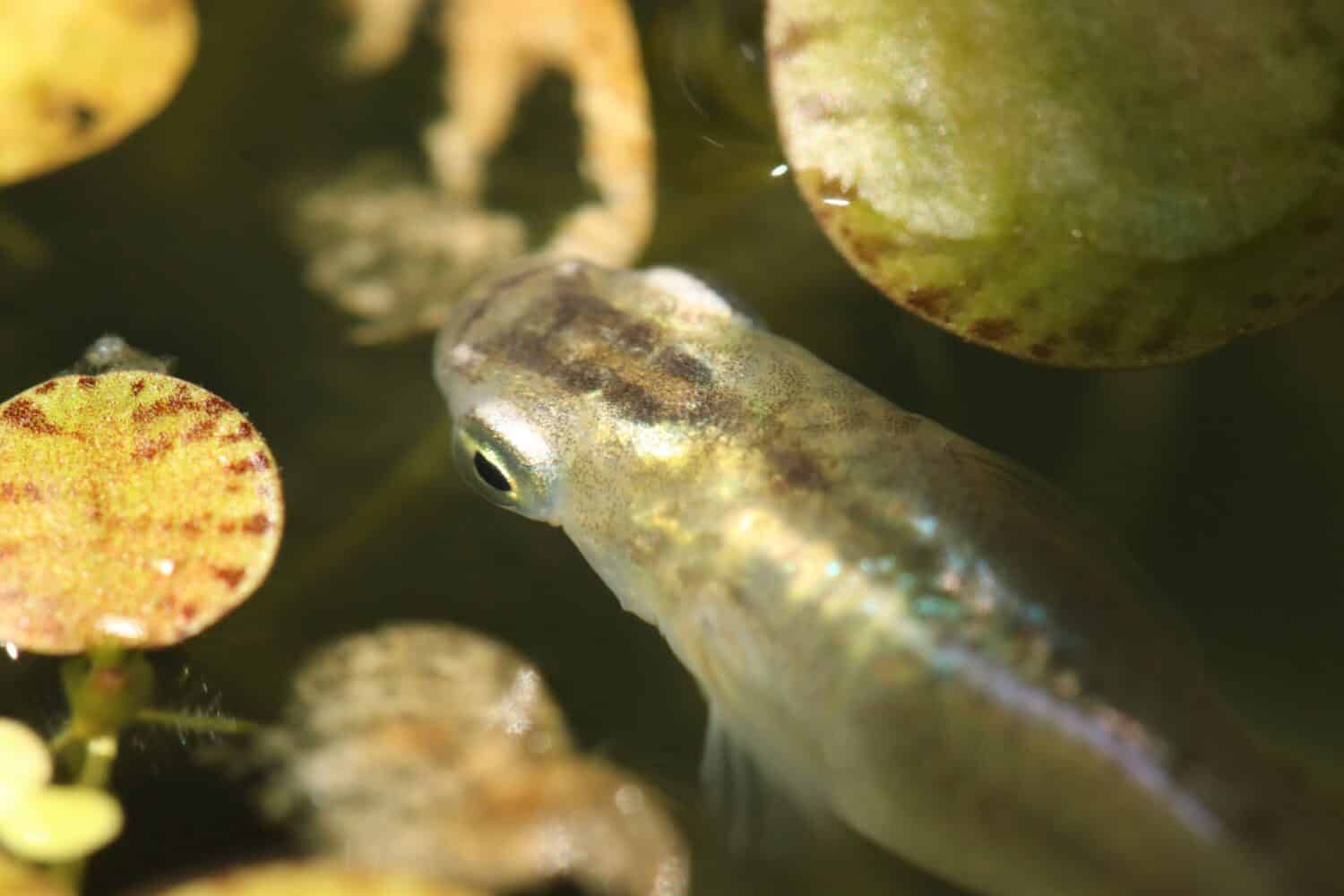
All killifish have two small eyes located on either side of their head.
©saiglobalnt/Shutterstock.com
The Werner’s or Aplocheilus werneri is native to Sri Lanka where they thrive in slow-moving rivers and streams. They grow to around 2.8 inches in size and have a lifespan of two to five years in captivity. They aren’t as colorful as other killifish and have a yellow body with black stripes. When breeding these fish, Werner’s killifish prefer slightly acid water with a peat substrate to deposit their eggs.
6. American Flagfish
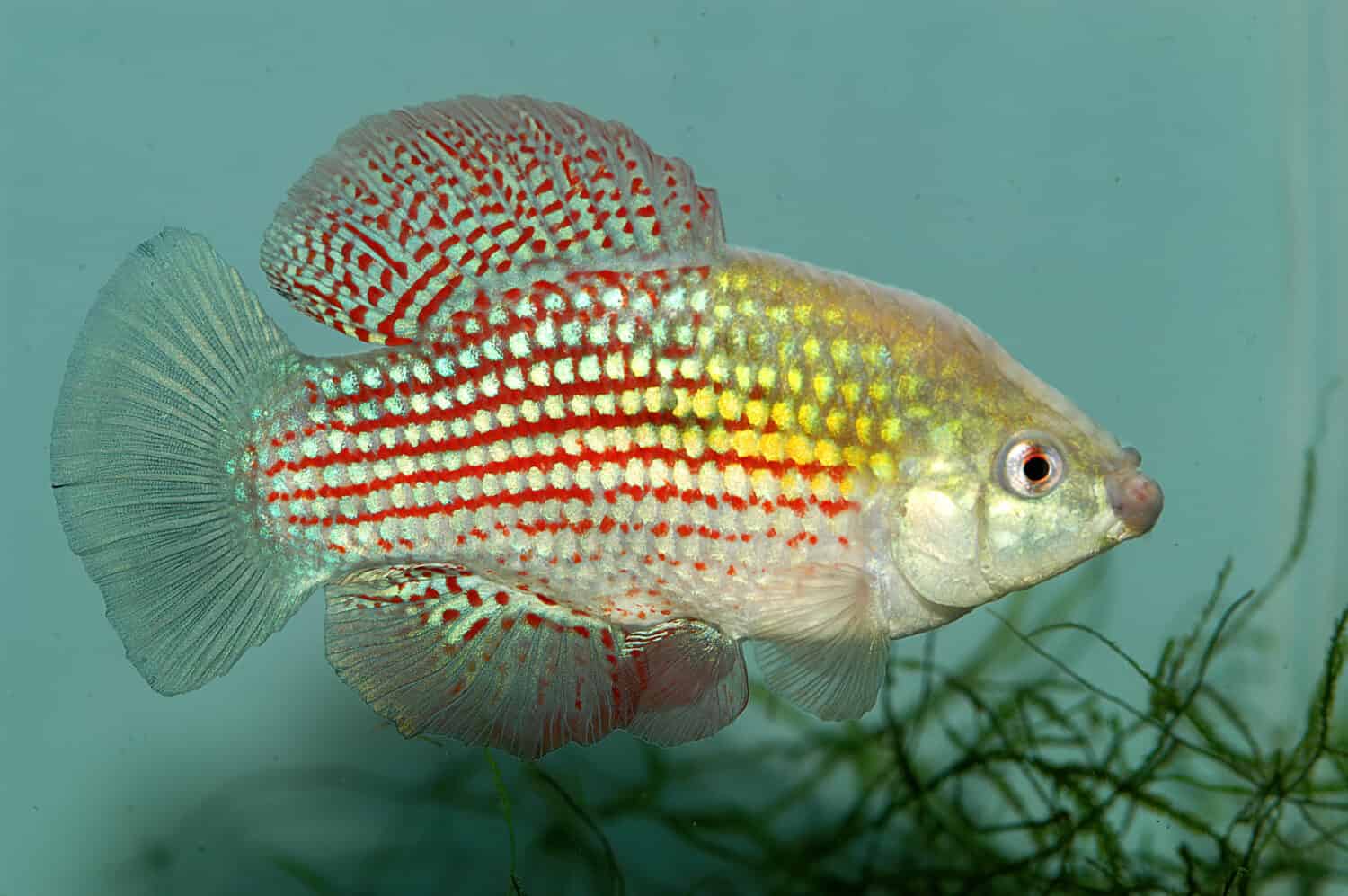
The American flatfish have a broader body than the usual pike-like killifishes.
©Karel Zahradka/Shutterstock.com
American flagfish or Jordanella floridae are endemic to Florida. They have a slightly broadened body with a reddish coloration for males. The females may have a slightly yellower body coloration. They don’t grow much larger than 2.5 inches and are relatively hardy and adaptable. When well-cared for, American flagfish can live for up to five years. They can be easy to breed if their conditions consist of good water quality, a moderate temperature, and no predators to eat any fry.
7. Blue Gularis
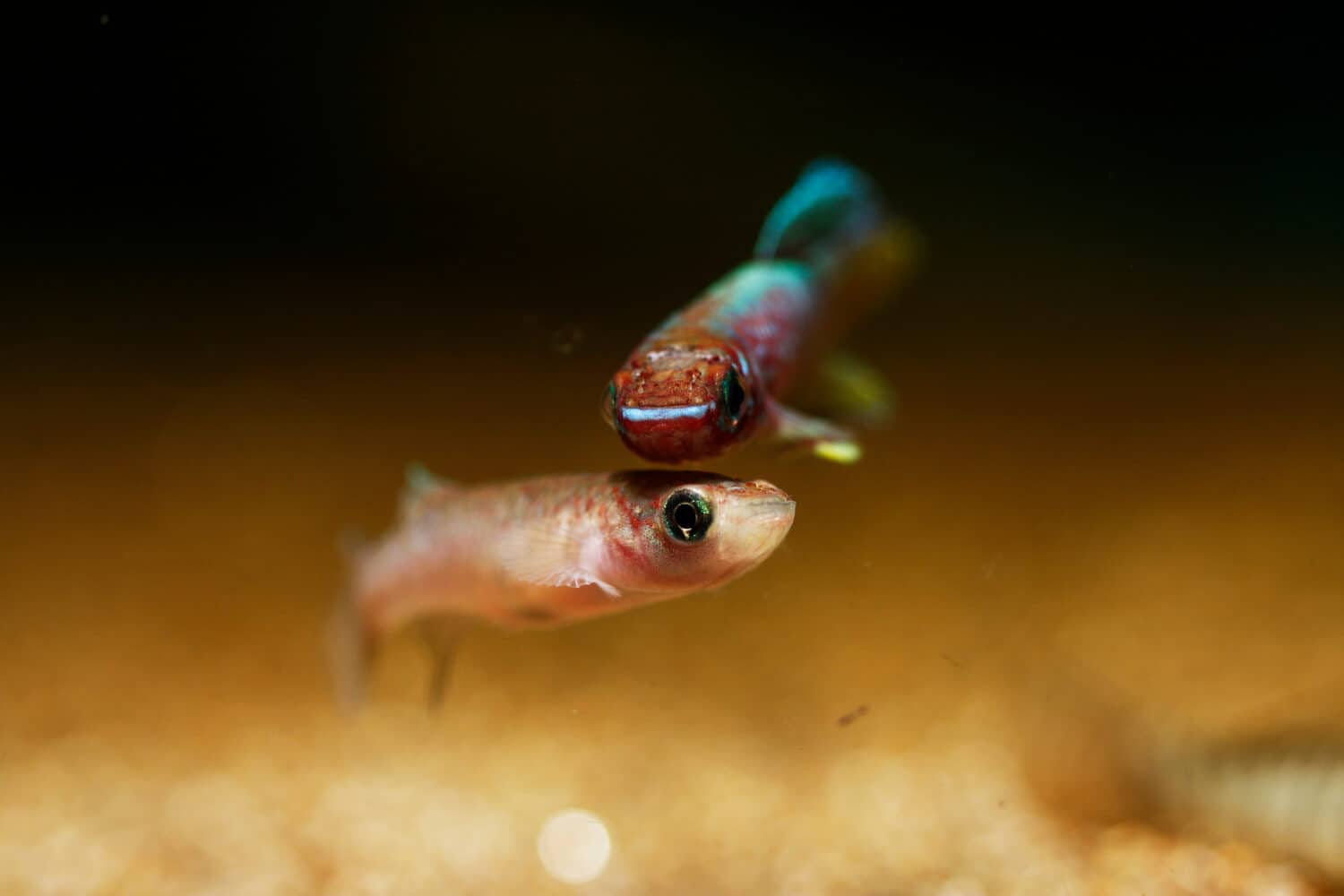
Male killifish are typically much more colorful than their female counterparts.
©Pavaphon Supanantananont/Shutterstock.com
The blue gularis, scientifically known as the Fundulopanchax sjoestedti are medium-sized killifish native to Nigeria and Cameroon. Blue gularis killifish grow to around 5.5 inches in size. They have a brilliant combination of blue, red, and orange colors with spotting and stripes. They can be higher in price than other pet killifish, and their long fins are distinguishable.
As a larger species of killifish, the blue gularis benefits from a minimum tank size of 20 gallons and above. Males can be semi-aggressive, but you can keep them in species-specific tanks. Blue gularis can be easy to breed and require peat moss as an ideal spawning substrate.
8. Daisy’s Ricefish
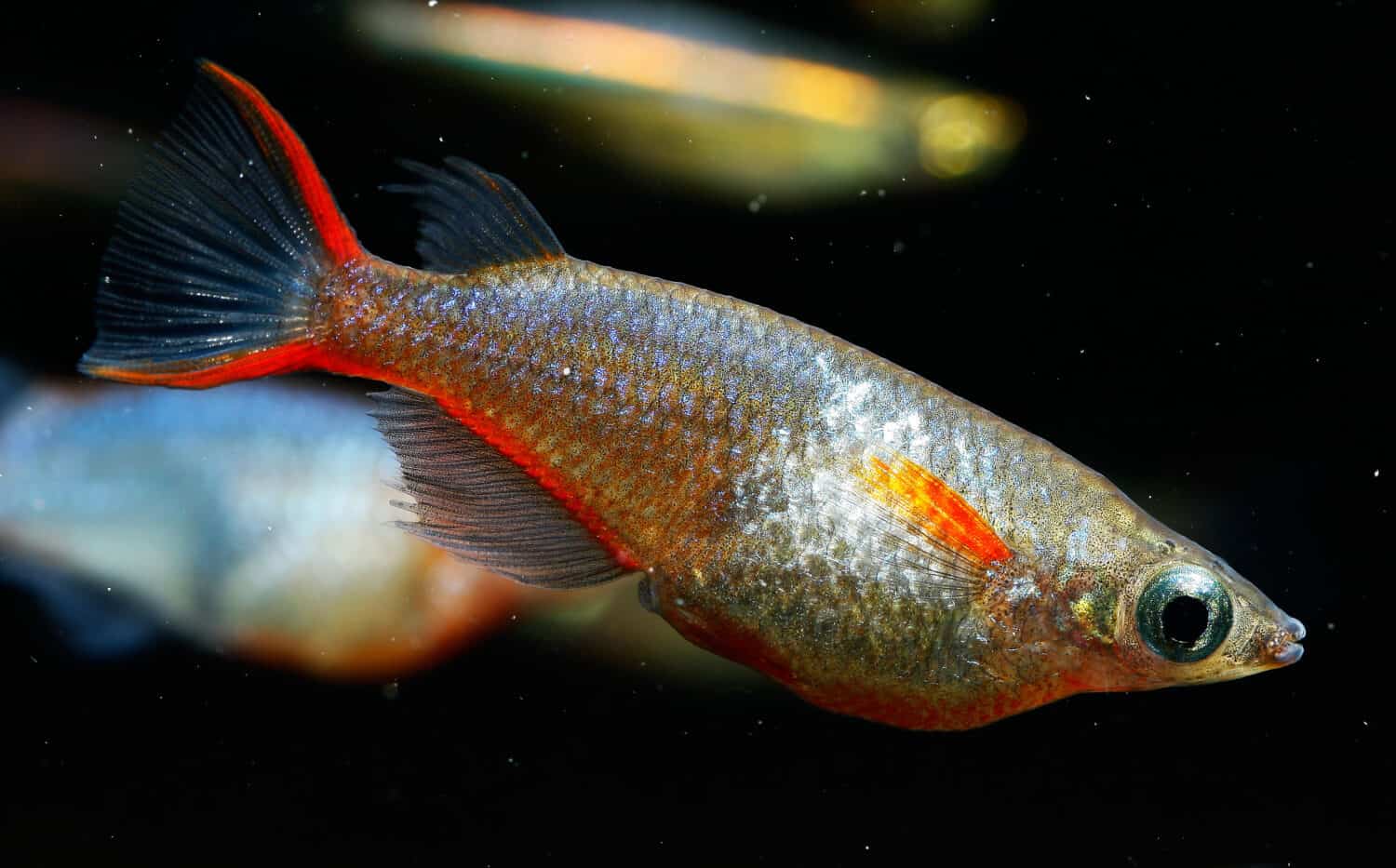
The daisy’s ricefish is smaller than many other species of killifish. They generally reach an adult size of 1.5 inches.
©Pavaphon Supanantananont/Shutterstock.com
The daisy’s rice fish or Oryzias woworae are small killifish originally from Indonesia. You can expect these killifish to reach a size of 1.5 inches, making them perfect for nano aquariums. The daisy’s ricefish is quite social and they do best in species-specific groups. Their body coloration is fairly simple and consists of blue and yellows with red stripes. Males are much more vibrantly colored than females. You can expect your daisy’s ricefish to live up to four years in captivity.
They are easy to breed and maintain in ideal conditions. When left to mature in good water quality and a densely vegetated aquarium, these killifish will begin spawning.
9. Magnificus Killifish
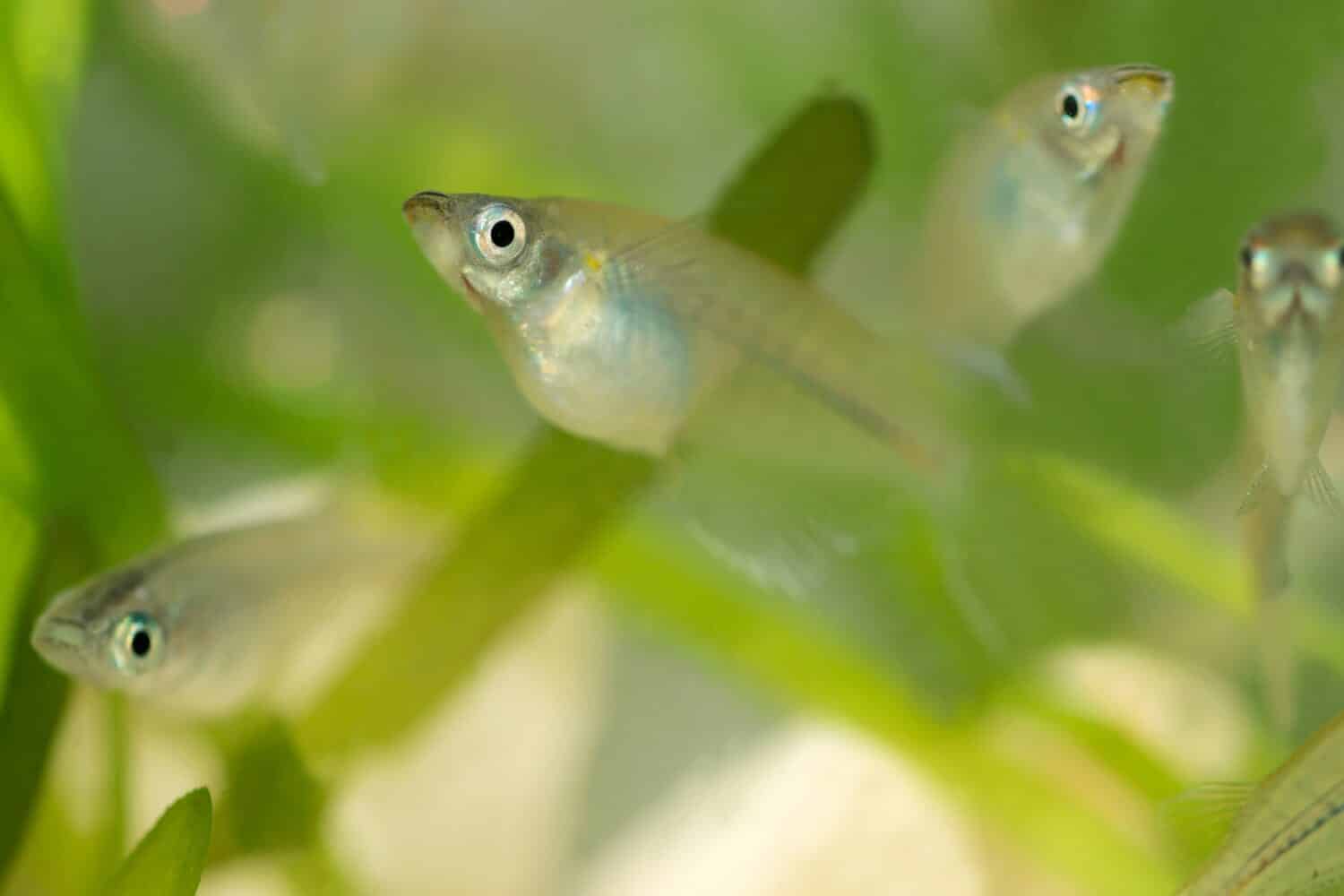
Many species of killifish are social and enjoy being kept together in schools.
©saiglobalnt/Shutterstock.com
A peaceful and colorful species is the magnificus killifish, scientifically known as the Simpsonichthys magnificus. These killifish don’t grow very large at 2 inches long and have an average lifespan of three to five years. They are native to South America and can adapt to different aquarium water conditions.
Magnificus killifish thrive in tropical freshwater aquariums and have a fairly peaceful temperament. Magnificus killifish have a bright golden blue and red coloration, with females being less colorful than males. They prefer to spawn in peat or java moss where their eggs and fry can be protected.
General FAQ
What do killifish eat?
Most killifish are either carnivores or omnivores. Their dietary requirements can vary depending on their species. However, most killifish thrive on a diet of species-specific pellets and live or frozen foods. These live aquarium foods consist of daphnia, baby brine shrimp, mysis shrimp, and even mosquito larvae. Like most aquarium fish, killifish can eat once or twice a day.
Summary of 14 Types of Killifish
| Number | Type of Killifish |
|---|---|
| #1 | Blue notho (Nothobranchius rachovii) |
| #2 | Redtail notho (Nothobranchius guentheri) |
| #3 | Argentine pearlfish (Austrolebias nigripinnis) |
| #4 | Blue lyretail (Fundulopanchax gardneri) |
| #5 | Large-finned lampeye (Procatopus notoaenia) |
| #6 | Red lyretail (Aphyosemion bivittatum) |
| #7 | Clown killifish (Epiplatys annulatas) |
| #8 | Golden lyretail (Aphyosemion australe) |
| #9 | Red-striped killifish (Aphyosemion striatum) |
| #10 | Werner’s killifish (Aplocheilus werneri) |
| #11 | American flagfish (Jordanella floridae) |
| #12 | Blue gularis (Fundulopanchax sjoestedti) |
| #13 | Daisy’s ricefish (Oryzias woworae) |
| #14 | Magnificus killifish (Simpsonichthys magnificus) |
The photo featured at the top of this post is © Pavaphon Supanantananont/Shutterstock.com
Thank you for reading! Have some feedback for us? Contact the AZ Animals editorial team.






